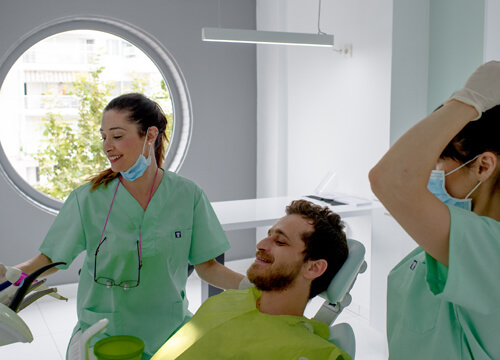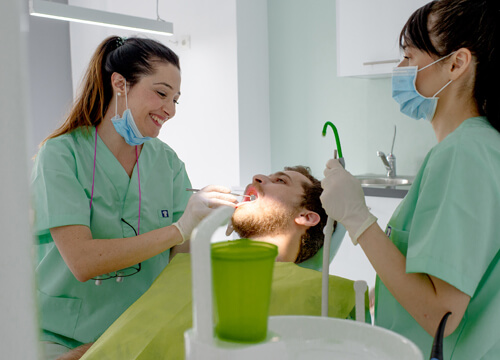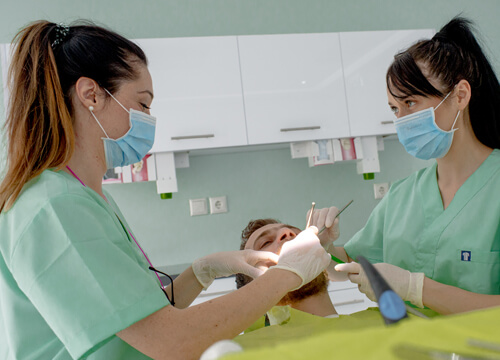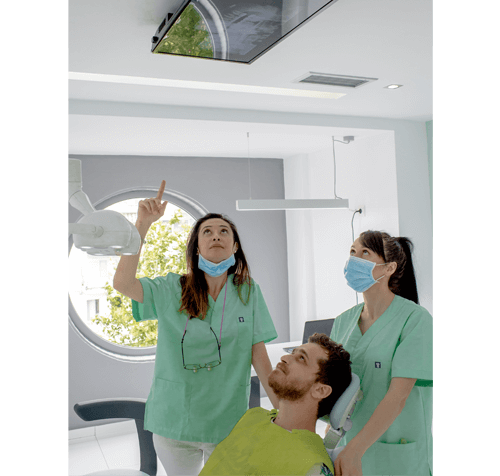
DENTAL CARE FOR ADULTS
Our goal is to achieve oral health & excellent aesthetic results for our patients. Health and beauty for your teeth!
Prosthodontics
Prosthodontics is a field of Dentistry that includes the replacement of missing teeth, with the use of fixed or removable dental prostheses. In the dental clinic NK Dental, in Kalamaria, Thessaloniki, we plan and manufacture -in collaboration with dental laboratories- prosthetic restorations, in order to restore the correct function and aesthetics of damaged or missing teeth.

- Crowns: Crowns are applied when a tooth has suffered significant damage either from a fracture, or from a large caries, or after endodontic treatment. In such cases, the extent of damage cannot be restored through a filling and thus a dental crown is chosen.
- Dental bridges: fill the gap with artificial teeth when one or more teeth are missing. The bridge is held in place for many years through dental crowns cemented on adjacent teeth.
- Inlays and Onlays: are aesthetic restorations for posterior teeth and are made of ceramic or composite materials, in a specialized dental laboratory. They are manufactured for teeth that present excessive damage instead of simple fillings.
In cases where the patient has lost many teeth, the placement of a complete or partial denture which is supported by the remaining teeth and gums, is indicated. These dentures can be removed from the mouth by the patient for cleaning and be easily repositioned. They fulfill the function of chewing, talking and restore aesthetics..
Cosmetic Dentistry
Aesthetic Dentistry is a branch of Dentistry that deals with repairing and improving the appearance of the teeth, the gums and, in general, the smile of every person. A white and aesthetic smile is associated with the overall improvement of psychology and self-confidence for both women and men!
What is Aesthetic Dentistry?
The need of patients for a beautiful smile has contributed to the development of a variety of different techniques in the field of Aesthetic Dentistry. Some of the most popular treatment strategies are teeth whitening - bleaching, porcelain and composite veneers, etc. More specifically, some of the applied techniques of Aesthetic Dentistry in NK Dental -by the dentist Dr. Katia Sarafidou - are:- Tooth bleaching
- Ceramic veneers – Lumineers
- Composite veneers
- Wedding Smile
- Silver-colored dental Fillings – Amalgam
Implantology
Implantology is a scientific field of Dentistry that deals with the replacement of one or more missing teeth with dental implants. The implants are placed inside the bone of the upper or lower jaw. Gradually a strong bond between the surface of the implant and the bone develops (osseointegration). Adjacent natural teeth are not affected by this process.

Implant-supported restorations consist of two parts: the titanium implant body that replaces the missing tooth root, and the prosthesis that replaces the part of the tooth that is visible inside the mouth. In particular, the implant body is placed through a quick surgical technique into the bone of the upper or lower jaw, respectively. After the implant integrates in our body, an artificial tooth is fabricated in the dental laboratory and is consequently fixed on the implant body.
Implant restorations are aesthetic and the best type of prosthesis that can be applied to replace natural teeth. In particular, the sense during chewing is almost the same as that that we have with our natural teeth. Implant-supported prostheses present very good survival rates on the long-term. For more information about implantology and dental implants, all you have to do is contact our doctors at NK Dental.
Oral Surgery - Extraction of a tooth or wisdom teeth
Oral Surgery is a field of Dentistry that involves repairing damage of gingival tissues or teeth using surgical methods.
Whether it is a damaged tooth or a problematic wisdom tooth, tooth extraction is the classic method of dealing with such dental problems. In case of an abscess (severe swelling and pus), surgical rupture may be needed. Other surgery treatments include the placement of dental implants, clinical elongation of the dental crown, treatment of gingival recession and regenerative techniques for osteogenesis, in case of extensive jaw resorption.
Endodontics / Root canal treatment
Endodontics is a field of Dentistry dealing with the treatment of pulp (nerve) diseases or periapical lesions. During root canal treatment, the nerve and blood vessels are removed from the pulp chamber and the root canals. The procedure is then completed by disinfecting and filling the dental roots with a special material (gutta-percha).

- Is root canal treatment painful?
- Root canal treatment completed
what next? - Why are Endodontics important?
Periodontics: Gingivitis, Periodontal Disease, Receding Gums
Periodontics is a dental specialty that focuses on the treatment of diseases located on tissues surrounding teeth. It concerns diseases of the gums and the bone of the upper and lower jaw. The most common diseases of periodontal tissues are periodontitis, gingivitis and gum recession. Usually, these problems are caused by plaque accumulation on teeth.

- What is gingivitis?
- What is periodontitis?
- What is gum recession?
- What is the treatment of
periodontal diseases?
Temporomandibular disorders
The temporomandibular joint is one of the most complex joints in the human body. It is a double joint (one on the right and one on the left side), which connects the lower jaw with the human skull. The health of the stomatognathic system is particularly important, as disorders in this area can cause severe headaches, difficulty in chewing, tinnitus etc.
- What are temporomandibular
disorders? - Bruxism (teeth grinding)
- Treatment of temporomandibular
disorders
